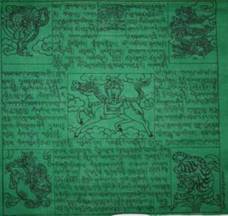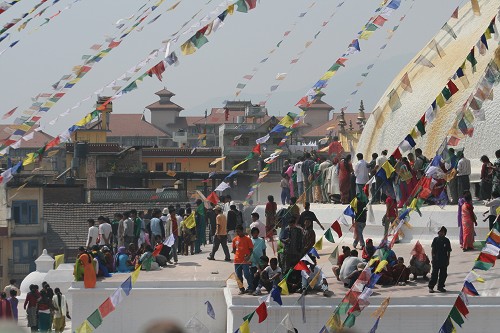


 |
 |
 |
All About Tibetan Prayer Flags
Prayer flags are a common sight throughout the Buddhist regions of the world, draped from homes and trees, on hill tops, mountain passes and around religious sites such as monasteries and stupas.
But why do people go to all the effort of taking flags half way up a huge mountain? Apart from being bright and attractive to look at, the flags have a serious side and each type of flag has a different purpose, carries different images and contains different mantra, or prayers.
Buddhists believe that as the wind moves the flags, so the prayers and mantras are carried on the wind, to the benefit of all sentient beings. Sentient beings are all the life forms that can appreciate both well being and misery. We are very good at understanding happyness and pain, but many animals, fish and insects also have an understanding of being safe and comfortable, or scared and in pain. Some people might think this is odd, but really, flying flags is no different to anyother form of prayer or meditation. Most religions teach that you can silently pray to a god, and he/she will hear your thoughts.
Prayer flags are produced using carved wooden printing blocks, black ink and yellow, green, red, white, and blue cloth. Printing blocks are often carved by monks or nuns, although there is nothing to stop any person from carving them. In fact, many settlements do have somebody who carves blocks and prints flags locally. The colours used for the flags represent the five Buddha families and the five elements.
Green = Amoghasiddhi Buddha and air. Red = Amitabha Buddha and fire White = Ratna Sambhava Buddha and water. Blue = Akshobhya Buddha and space. |
 |
There are quite a variety of different designs, but two common flag designs are the Wind Horse ( Lung-ta) and the Tara. These are seen all over Nepal and parts of Northern India such as Darjeeling and Sikkim. In the past they were seen all over Tibet too, but since the Chinese invasion of Tibet in 1954, it has been very dangerous to openly practice a religion or do anything that would suggest that Tibet has it's own culture. People have been put in prison and even died because they openly practiced Buddhism or followed traditions such as producing prayer flags.
Wind Horse flags are by far the most common prayer flag. The flag is believed to bring good fortune. The wind horse, usually in pictorial form, always occupies the centre of this flag. The texts on the flags vary but usually consist of a collection of mantras or a short sutra.
 The four great animals always guard the four corners of the flag: Garuda, Dragon, Tiger and Snow lion.
The four great animals always guard the four corners of the flag: Garuda, Dragon, Tiger and Snow lion.
Flying Horse represents accomplishment of positive works in a most suitable and instant way.
Garuda eating a snake represents the frightening away of evil thoughts or intentions.
Dragon represents the removal of different threats from the sky, such as lightening and storms
Tiger represents each step of life without hurdles or obstacles.
Lion is the front-runner in each step of life.
 Tara flags are also frequently seen and are believed to promote compassion.
Tara flags are also frequently seen and are believed to promote compassion.
This is because Tara was born from the compassionate tears of Avalokiteshvara. As he shed tears at the thought of all the suffering that sentient beings must endure, one of the tear drops transformed into the Green Tara who then manifested herself in an additional twenty other forms. Tara flags usually show the Green Tara in the centre and often conclude with her mantra OM TARE TUTARE TURE SOHA. Tara is a female Buddha and has eyes in her hands & forehead with which she is able to see all human pain. The purpose of this flag is to spread compassionate blessings.
Hanging Flags
Flags should be hung in the correct sequence, from left to right, with yellow first, then green, red, white and blue last. Most flags come already strung on cord so it’s rare to have to sort them out yourself. Traditionally they are hung outside to catch the wind, but they may also be hung indoors where even slight air movements will still send their benefits out to the world.
For the best effect they are hung on an auspicious day or at an auspicious moment, such as early on a windy morning, especially on a Friday. Try to avoid hanging new flags on Tuesdays and Saturdays.
 |
Prayer flags flying at a Buddhist Temple in the city of Darjeeling, Northern India |
Caring For Flags
Flags have frayed edges. This is traditional and not a design defect. Many believe that as the edges fray and threads are blown away, they confer blessings on the ground where they fall. It is traditional to hang flags outside and leave them until they need to be replaced. They will often last several years, taking on a frayed and faded look. New flags can be hung at any auspicious time, and the New Year often sees old flags taken down and new ones flown.
If you have flags at home or in your school, you should make sure that they are not allowed to touch the ground, and always remember that they are religious items that demand respect. Please don’t use them to patch clothing, make them into curtains, furniture coverings or similar things, and never associate them with intoxicants such as tobacco or alcohol.
Old flags that are nolonger wanted should be burnt not thrown in a rubbish bin.
If you or your school would like to buy some prayer flags you can get some here.

Prayer flags flying at Boudha Stupa, Kathmandu, Nepal
We recommend Made In Nepal as an excellent source of prayer flags
![]()